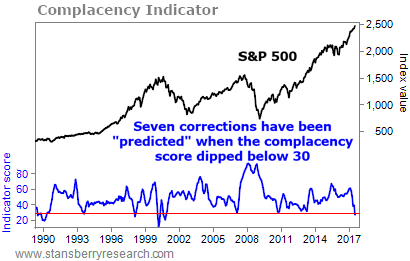The Weekend Edition is pulled from the daily Stansberry Digest. The Digest comes free with a subscription to any of our premium products.
.jpg)
The signs started to appear months ago...
Last summer, Stansberry Research founder Porter Stansberry warned that a significant stock market correction – or possibly something much worse – was now certain for the first time in years. As he explained in the August 4 Stansberry Digest...
|
In the fall, Porter went even further...
He said that it was simply a matter of time before the so-called "short volatility" trade imploded. And he warned that this could trigger a market panic... and potentially even set off the crisis he's been predicting.
Of course, he was exactly right...
The short-volatility trade did implode last week, just as Porter predicted. And the resulting sell-off pushed stocks into official "correction" territory – defined as a decline of 10% or more from a high – for the first time in two years.
Surely, Porter is even more bearish now? Surely, he's preparing for further downside... and the start of the serious crisis he has been predicting?
Not exactly. As he wrote in the February 9 Digest...
|
As Porter explained, we haven't seen the "Lucent Moment" yet...
This is when one of the "darlings" of the preceding boom begins to falter... And it often marks the unofficial start of the bust to follow.
Near the end of the Internet boom in the late 1990s, telecom firm Lucent Technologies collapsed after an earnings miss in January 2000. The broad market peaked less than two months later… and went on to lose 50%-80% over the next two years.
During the housing boom and bust last decade, it was the failure of mortgage giants Fannie Mae and Freddie Mac in July 2008 that kicked off the real crisis.
In other words, Porter doesn't believe this boom will end until we see similar signs of trouble in today's tech darlings... And that simply isn't the case today.
So rather than make him more bearish, the recent volatility has made him more bullish, at least in the near term. More from the February 9 Digest...
|
History suggests Porter will be right once more...
In a research note published this week, analysts at financial-services company Canaccord Genuity noted that the big recent spike in volatility created an unusual situation. As the CBOE Volatility Index ("VIX") soared to more than 50, it pushed one significant momentum indicator – known as the "10-week rate of change" – above 125.
The ins and outs of this indicator aren't really important here. All you need to know is this extreme is rare. It has only happened four times in the 25-year history of the VIX. And more important, all four instances were followed by additional short-term volatility and at least slightly lower lows in stocks.
The first occurred in September 1998, following the collapse of Long-Term Capital Management that August. After "bouncing" off its lows, the S&P 500 Index fell another 4.9% over the four weeks following this signal before bottoming in early October.
The second was in October 2008 – at the peak of the last financial crisis. Again, stocks bounced... And again, they made a lower low. The S&P 500 fell another 24.8% following this signal before bottoming in March 2009.
The third followed the so-called "Flash Crash" in May 2010, while the fourth occurred during the big market decline in the summer of 2011. And like before, the S&P 500 went on to make a lower low. It fell another 6.0% and 2.2%, respectively, after those extremes.
In short, we may not be out of the woods yet. Stocks could fall to new lows in the coming weeks. But more important, history suggests it will be a great time to buy if they do.
One last thing...
As you've likely heard, the recent volatility hasn't been limited to the traditional financial markets. Bitcoin and other cryptocurrencies have suffered jaw-dropping declines, too.
After soaring to almost $20,000 in December, bitcoin plunged nearly 70% through the first week of February. Countless other "cryptos" fell even more in that stretch.
But while many folks are worried that the crypto "bubble" has burst, our colleague Tama Churchouse remains incredibly bullish.
If you're not familiar, Tama works for our corporate affiliate Stansberry Churchouse Research, and he's one of the most knowledgeable crypto analysts we know.
Tama is convinced the crypto bull market is intact… and believes this recent volatility is offering a second chance to make life-changing gains in these markets this year.
In fact, he not only expects bitcoin to recover all of its recent losses this year, he believes it could reach a new high of $50,000. That's more than five times higher than today's prices… and he expects many of his favorite crypto recommendations will soar multiples more.
If you were kicking yourself for missing out on the big gains in cryptocurrencies last year, you owe it to yourself to learn more. Click here for the details.
Regards,
Justin Brill
Editor's note: If you want to make money in cryptocurrencies, you must remember one thing... The recent volatility we've seen is normal. In fact, after the recent sell-off, Tama believes 2018 will be the most profitable year yet for crypto investors. He recently detailed how you could potentially make thousands of dollars a month in profit. Get the details here.


